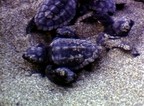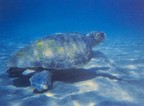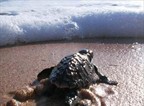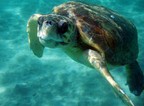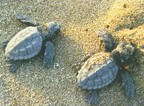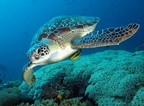Evolution and adaptation
The records of fossils suggest that sea turtles caretta caretta are contemporaries of the dinosaurs. Although dinosaurs disappeared, turtles continue to survive until today. Those ancient turtles lived in marshes. Later some of them began to live on land while others spent most of their lives in water. Throughout the evolutionary process sea turtles have retained the following features:
• Like all reptiles they are coldblooded, which means that they use the heat of the environment as the main source of maintaining body heat.
• Resemble primitive amphibians and birds that have a single small bone in the ear to catch sounds. Sea turtles are particularly sensitive to low frequencies like ground vibrations and waves.
• They have lungs and breathe air.
• They nest on land.
• The heart is divided into two atria and one ventricle, which results in incomplete double circulation, which means they can withstand a relatively high level of carbon dioxide in their blood.
• The body is protected in a shell. The exception is the leatherback (Dermochelys coriacea) with leathery skin shell.
Morphology
The shell: The shell is the most noticeable feature of all turtles. Consisting of a number of bones, it protects like armor the soft vital organs. It consists mainly of 2 parts: the upper shell or carapace and plastron, or bottom. Tortoises and freshwater shells are often dome-shaped, allowing them to withdraw their head and feet inside the shell when threatened. Sea turtles like caretta caretta do not have this ability. The evolutionary process has equipped them with hydrodynamic shaped carapaces.
Propulsion: With time the stumpy feet of land turtles evolved into the flattened flippers of sea turtles. The front flippers are used for propulsion while the rear flippers act as rudders.
Respiration: Turtles breathe with lungs. This forces them to regularly surface to take in air. As mentioned earlier, sea turtles can tolerate higher concentrations of carbon dioxide in their blood than most other air-breathing animals. Furthermore, both tissue and blood muscle can store oxygen in large quantities. This allows them to spend many hours or days under water.
Habitat
Essentially, sea-turtles live in the marine environment where they mate, feed, migrate and hibernate. Females return ashore to dig nests and lay eggs. Males will almost never return to land. Little is known about the youthful years of marine turtle. After the eggs hatch, the hatchlings crawl to the sea. For the first 24 hours they swim towards the sea. Once in the open sea they are allowed to drift with the currents. Little is known about what happens next until the time they return to their breeding habitats to breed. It is believed that during their pelagic stage they first feed on plankton and insects then shellfish, molluscs and other organisms of the high seas. After the pelagic stage turtles live in coastal waters, except Lepidochelys olivacea and leatherback that remain pelagic throughout their lives.
Dietary habits
Caretta caretta turtles do not have the speed and agility to catch fast-moving prey. For most they feed on slow moving or sedentary animals such as crustaceans, jellyfish, molluscs, sea urchins, crabs, sponges and sea grasses. Turtles have been found to have a well developed sense of smell that can help them locate food.
Reproduction
When it comes to reproduction, adult sea turtles migrate to their nesting areas. Mating takes place during migration, as well as in waters near nesting beaches. Shortly after mating, the females approach the beaches to dig nests and lay their eggs. Most species nest at night, except Lepidochelys that nest during the day. The most spectacular is the “arribada” (“arrival” in Spanish) of Lepidochelys olivacea when thousands of turtles come to nest simultaneously within a few days.
Nesting
Leaving the water, the female caretta caretta sea turtle crawls up the beach to find a place suitable for nesting. If bothered by noise or lights on the beach it can return to the sea without laying eggs. Once the female has found a place to give birth, it makes a pit for the body of sweeping away the dry sand with its flippers. After using alternating movements of her rear flippers, it digs a hole in the shape of the bottle, the egg chamber. When the turtle has finished digging, it lays its eggs inside the egg chamber one to one or two at a time. During the nesting eyes secreting tears, is a liquid from a special gland. This fluid eliminates excess salt, and also to keep its eyes moist and free from sand. Immediately after spawning runs, it starts covering the egg chamber. When this is complete, the turtle starts to press firmly the loose sand over the eggs with the rear flippers. Then it returns to the sea. During a breeding season a female makes 2-4 nests. Generally, sea turtles nest every 2-4 years.
Incubation
Eggs hatch in 7-10 weeks, depending on the temperature of the sand. As hatchlings emerge from the eggs, they struggle to climb to the surface. Because oxygen is scarce, this upward movement can take 2-4 days. When they reach the surface of the sand during the day, they stop any further movement because high temperatures inactivate them. They wait just below the surface until the sand cools at night or early in the morning and then leave en masse and run towards the sea. Starlight leads them to water. With such a large number of eggs, nests usually hatch in installments. For instance, in Greece, a nest of 110 eggs can give 35-50 chicks first time and then for 2-10 more days to go 2-3 smaller groups of 5-20 chicks. Some of the eggs are unfertilized or contain dead embryos.
Threats to survival
The International Union for Conservation of Nature (IUCN) has declared 6 of the 7 species of sea turtles as endangered or critically endangered. Threats to sea turtles are both natural and manmade.
Physical threats:
There are certainly physical threats to the survival of caretta caretta sea turtles, chicks and eggs. The weather is a prime factor. The wind, rain and cold and abnormally high temperatures also affect the turtles at all stages of their lives. Temperatures below 14oC “freeze” even adult turtles. The erosion destroys nesting beaches. The natural enemies of eggs and hatchlings vary depending on geographic location. In Greece, foxes, dogs and jackals can sometimes dig up the eggs. The chicks run to the sea sometimes eaten by these animals as well as ferrets or rats or birds such as crows, gulls and cormorants. Once the hatchlings reach the sea, they are sometimes devoured by large fish.
Threats from human:
- Poaching eggs for consumption
- Entanglement in fishing gear resulting in drowning or being killed by fishermen
- The beaches are shrinking dramatically due to residential development and tourism activities
Sea turtles in Greece
Of the 7 species in the world, only 3 are found regularly in the Mediterranean (Caretta caretta, Chelonia mydas and Dermochelys coriacea). Of these 3 species only loggerhead is nesting in Greece. The most important nesting beaches are in Zante (Laganas Bay), Peloponnese (Gulf Kyparissia Laconic Gulf, crown area) and Crete (Rethymno, Chania and Messara Bays). The beaches of Zante have a particularly high density of nests. The density on a beach (Sekania) can reach about 1,500 nests per kilometer and is the highest in the world. The carapace of the turtle has a heart shape with 5 pairs of lateral plates. The color of the shell is brown-green. The plastron is pale yellow. Turtles tagged in Greece have been identified in a wide area of eastern Mediterranean even at distances of 1,500 km on Italian, Tunisian, Libyan waters, suggesting deliberate and not accidental movement. Most comments are from the Gulf of Gabes in Tunisia and the northern part of the Adriatic Sea, which means that these bays are wintering turtles that are nesting in Greece.
